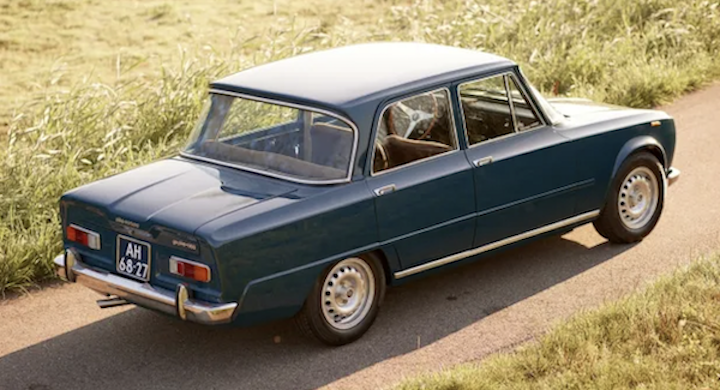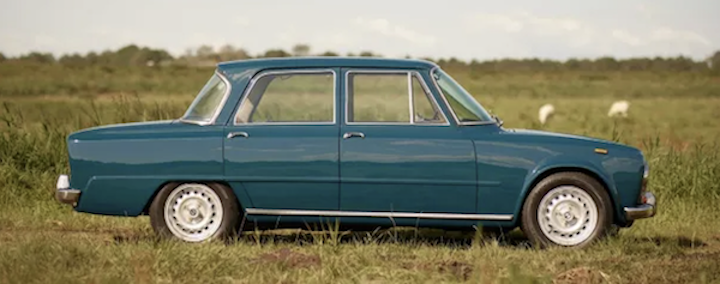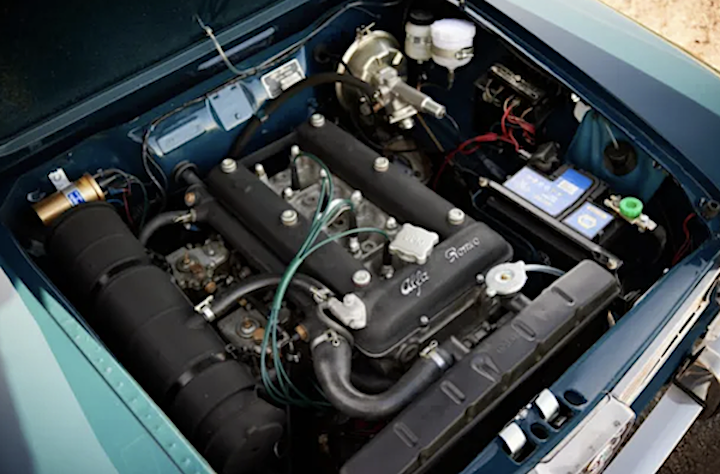Back to basics — Remembering the Alfa Romeo Giulia Berlina

1965 Alfa Romeo Giulia Berlina
By David Boldt
MyCarData
(February 5, 2024) If you’re an automotive enthusiast not yet familiar with Bring-a-Trailer, an automotive hot spot offering virtually anything with an engine, you should get familiar. And despite BaT’s premise as an auction site, you don’t need to bring money; in fact, it’s better if you don’t.
I visit Bring-a-Trailer most days, and on one of those days the site’s inventory included what looked to be a pristine 1965 Alfa Romeo Giulia Berlina. This small 4-door of the mid-sixties combined jewel-like construction and power (its standard DOHC four was all of 1.3 liters, roughly the same displacement as a contemporary Beetle) with an upright architecture and generous greenhouse. And while the Giulia Berlina didn’t possess the cachet of Alfa’s coupes and spiders, almost six decades later it offers cachet in spades. Today, Alfa Romeo should bottle it — and then sell the hell out of it.
For reasons unknown to me, the U.S. market has been a tough one for the Italians and — similarly — the French. Both countries offer compelling designs built atop interesting or visceral platforms...and those cars go nowhere in the U.S. marketplace. Today’s Alfa Romeo showroom, which is often paired with Maserati, features both the Giulia sedan — a 3 Series/C-Class competitor — as well as the Stelvio crossover; the Stelvio is built on the same platform as the Giulia, but offers a more versatile 5-door layout. Both models come with standard 4-cylinder powertrains (which are responsive) and V6-propelled Quadrifoglios, capable of on-road heroics.
I like the Giulia a lot. But it’s one size too large to enjoy as a flickable platform, and at least $10K too expensive to be considered accessible for singles and young families. But if its size does work for you, buy one before the next Giulia grows inevitably bigger…and predictably more complicated.

1965 Alfa Romeo Giulia Berlina
More recently, Alfa has introduced the Tonale, a small crossover with a plug-in hybrid drivetrain and a platform shared with the Dodge (remember Dodge?) Hornet. Based on the ad campaign, it’s targeted at the same audience as BMW’s X1 or Mercedes B-Class: young professionals living — I’ll guess — in urban zip codes. But in establishing a spec attractive to women it seems to ignore those elements making Alfas attractive to men. (As most retailers know, women will buy vehicles spec’d for men, but few men will buy vehicles designed for women.) The Tonale, in its current guise, is essentially a non-starter.
With my limited experience — 12 years on import showrooms, followed by roughly 30 years in automotive journalism or automotive PR — I believe Alfa and its U.S. subsidiary need to go where the other OEMs aren’t. And the design of this ’65 Giulia Berlina could be a start.
Building a small, simplistic 4-door with a conventional powertrain, no nanny aids, and on the dash little more than an AM-FM head unit would give young families a motoring experience not unlike Mazda’s Miata or Subaru’s BR-Z, but with the convenience of four doors and an upright architecture. Under the hood a twin cam, normally aspirated powertrain – in the traditional Alfa mold — would be good, and the folks at Mazda could supply one. If that idea doesn’t fly, Stellantis has a 1.3 liter turbo four capable of providing similar performance and, we’d guess, competitive efficiency.

1965 Alfa Romeo Giulia Berlina engine
Attach what’s under the hood to a standard manual trans or optional dual-clutch transmission, tune the ride/handling mix to one that’s ‘sporting’ and keep the price point closer to $30K than $40,000. And with both the ICE platform and an (inevitably) EV sharing the costs of body stampings, you could make a business case for the new/old design selling in the latter half of this decade.
In its Neue Klasse lineup of EVs, BMW is about to introduce an upright architecture to the electric space. And a visit to any Cars and Coffee makes clear there’s a real affection for sport sedans (BMW and Benz from the ‘80s and ‘90s) with these same upright proportions and analog presentations. Alfa could expand its customer base by building a car no one else is building, while — concurrent with the Berlina’s intro — creating showroom environments no one else is offering.
Before you think the above premise is simply daft, take another look at the Berlina. What driving enthusiast wouldn’t want that?
